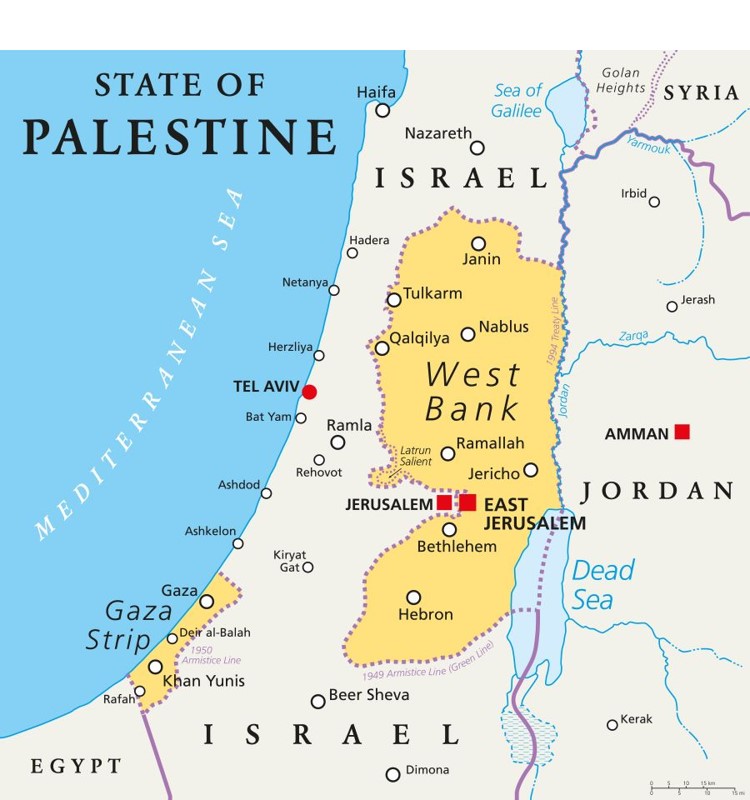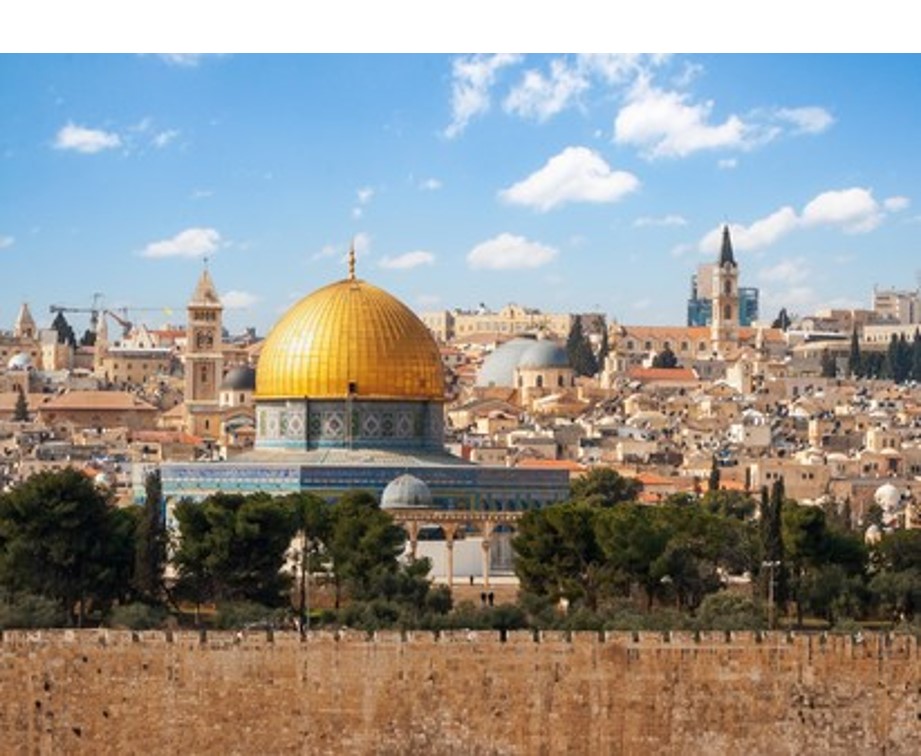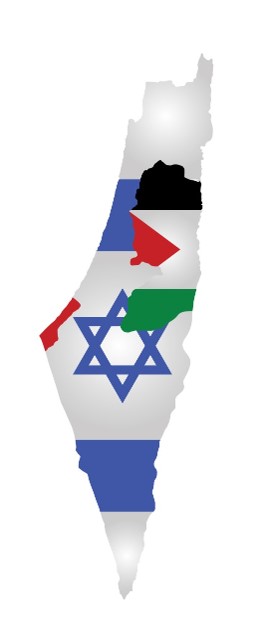Foreign Imposition – Part Two

Although fully recognized statehood has eluded the Palestinians for centuries, many people don’t know that the state of Palestine already exists as an observer state. Today, 139 of the 193 member states of the UN already recognize Palestine as state. [86] Comparatively, the state of Israel is recognized by 163 member states. Palestine includes East Jerusalem, the West Bank, and the Gaza Strip.
The following ten major countries do not recognize Palestine: Australia, Canada, France, Germany, Italy, Japan, South Korea, Mexico, the United Kingdom, and the United States. [87] On March 22, 2024, Spain, Ireland, Slovenia, and Malta have all agreed to recognize Palestine. [88]
On April 18, 2024, the United States vetoed Palestine’s request to become a full member of the United Nations. The U.S. was the only nation of the 15 members of the U.N. Security Council to vote “No”. [89]

Current Situation
● The Palestinians have suffered through 75 years of the government of Israel’s actions and remain under occupation. They either helplessly watch their land in the West Bank and East Jerusalem get confiscated or live in the Gaza war zone. Also, the government of Israel has also not been a serious partner in peace while Palestinians have negotiated under duress.
● The government of Israel’s policies and actions from the beginning make it clear that they want 100% of Palestine. The 78% of Palestine that is recognized internationally isn’t enough for them.
● The U.S. enables the government of Israel’s policies and actions. The U.S.’s “blind” support for Israel hurts our treasury and reputation around the world exposing our nation to retaliation from other actors. Also, the U.S. politicians are subjected to intense lobbying from organizations such as AIPAC.
● It is time for foreigners to intervene, but this time for the Palestinians.

Idea
The U.S. needs to be a “friend” and put the government of Israel on the righteous path to lasting peace and security.
● Recognize Palestine as a state and work with the other remaining nations to also recognize Palestine without any delays or conditions. Move to have Palestine become a member state of the United Nations.
● Afterward, have the government of Israel and the future government of Palestine negotiate the remaining key points. These points include land swaps, refugees, settlements, and such, after full recognition.
● Concurrently, secure peace with Israel and the Arab nations for the exchange of ending the occupation. The U.S. will guarantee its military support to Israel. The Arab nations have shown their willingness for such a resolution to this conflict.

Objections
Isn’t Recognition Only Symbolic?
Recognizing Palestine might seem merely symbolic and out of sequence because the occupation exists today. However, the government of Israel will not withdraw from those occupied territories willingly. Universal recognition of Palestine will isolate the government of Israel and give the Palestinians hope. It essentially ends the disputes over historical or religious rights to the land and diminishes AIPAC’s influence. Also, it creates leverage for a withdrawal of Israeli forces. Finally, radicalized militias will become less persuasive because Palestinians will have a voice.
Wouldn’t Recognition Reward Terrorism?
Some might say that the United States’ recognition of Palestine as a state might seem like we are rewarding terrorism. However, recognizing Palestine is decades overdue. Conversely, the U.S. recognized Israel as a state approximately one month after their terrorist attacks on Deir Yassin and others during the Nakba.
Moreover, isn’t the U.S. enabling and rewarding the aggressive actions of the government of Israel by not recognizing Palestine?
What Would Happen to the Existing Settlements?
The government of Israel built the settlements in the occupied territories against international law. Therefore, the government of Israel took that risk building them. Perhaps, the residents in those settlements can stay and become Palestinian citizens. Perhaps, Palestine could pay the settlers for their homes in those occupied territories. The government of Israel and of Palestine can negotiate settlements after Palestine is recognized.

Will Israel Have Security?
The prevailing philosophy in the government of Israel is “Security Through Settlements”. This concept generally means that an increased civilian population in the occupied territories creates more safety. However, this paradigm requires more Palestinian land theft. It also puts further constraints on Palestinians, consequently making it more difficult for them to move, work, and live.
The only way to peace is to remove the government of Israel’s figurative foot off of the Palestinian’s neck and end the occupation. Peace requires complete self-determination in a separate state. A Quasi-Palestinian State where the government of Israel maintains some sort of control and requires limitations won’t work. Palestine should be contiguous with defined borders and full control over their own destiny which includes air space, trade, maritime trade, and more.
Some say that if the government of Israel ends the occupation, the Palestinians will just get bigger and better weapons and then attack Israel. However, If the government of Israel can make peace with Egypt and Jordan who both share borders and previous wars without an issue, it can make peace with the Palestinians too. Furthermore, Hamas has indicated that they are willing to accept Palestine on the pre-1967 borders.

End Game – Palestine Statehood
One of the challenges with the government of Israel’s approach is the end game with the Palestinians. People used to say that the government of Israel needed to choose to have either a one-state or a two-state solution.
The one-state solution would mean that all of the Palestinians would be part of the state of Israel and would be equal citizens, resultantly outnumbering the Jewish population. A two-state solution has the states of Israel and Palestine standing side-by-side.
The challenge with these alternatives is that a one-state solution jeopardizes the Jewish majority, and the two-state solution gives up some of the government of Israel’s desired sovereignty. Both of these approaches respect the human rights of Palestinians.
The government of Israel does not appear to be choosing either solution. They continue to go down the apartheid path and build settlements surrounding the Palestinian enclaves. The Palestinians in these enclaves will continue to have few human rights and endure constant harassment and violence.
The other challenge with this approach — other than the obvious humanity — is Israel will never live in peace and security. The Palestinians will justifiably resist sometimes in ugly ways. Also, people in neighboring Arab nations will continue to sympathize and, in some cases, participate with them.

Opinion and Analysis – Palestine Statehood
As stated at the beginning, this website focuses on the government of Israel. It doesn’t criticize the citizens of Israel or challenge Israel’s right to exist. Certainly, we can appreciate the desire to leave Europe and Russia and establish a home in Palestine. Additionally, we can empathize with the inherited trauma of the Holocaust that has been passed forward generationally.
However, the Palestinians have lived in Palestine for many generations. What has happened to them in the last 100 years isn’t right. They should have their own fully recognized state in Palestine.
Finally, it is possible to support both Israel and Palestine. It isn’t a Democratic or a Republican issue nor a progressive or a conservative issue. It is a humanitarian and moral issue. We are better than this! If you want to be a “friend” of Israel, help the government of Israel get on the righteous path and end the occupation. It is time for the U.S. to recognize Palestine!

If you learned anything on this site, send it to people you know and discuss it with them. This is merely a communication tool. Spreading it through electronic word-of-mouth could make a difference.
Menu

References – Palestine Statehood
86) (February 6, 2024) What the U.S. Recognizing a Palestinian State Would Mean. nbcnews.com
87) Venditti, Bruno (November 10, 2023) Mapped: Recognition of Palestine by Country. visualcapitalist.com
88) Brzozowski, Alexandra Pugnet, Aurelie (March 22, 2024) Four More EU Countries Ready to Recognize Palestinian State “When Circumstances Right” Euractive.com
89) Borger, Julian (April 18, 2024) US Vetoes Palestinian Request for Full UN Membership theguardian.com